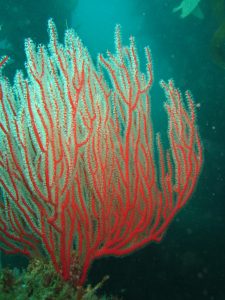Kelp forests provide important structural features and ecosystem function to coastal marine communities. The physical structure of kelp provides vertical habitat similar to trees on land; it is used by numerous fishes and invertebrates.

Two species account for the bulk of physical structure and kelp biomass in the northern California region: bull kelp, Nereocystis luetkeana, and giant kelp, Macrocystis pyrifera.
Bull kelp, which tolerates high wave action, is typical along exposed rocky shores, whereas giant kelp is abundant in all areas except the most exposed sites. Bull kelp is an annual, and giant kelp is a perennial but rarely lives longer than two to three years. Both species recruit in late spring and early summer. Where both species co-occur, such as along much of the Big Sur coastline in central California, bull kelp is often restricted to areas inshore of giant kelp and to the tops of pinnacles.

In addition to the canopy-forming species, there are several kelp species (e.g., Pterygophora californica, Laminaria spp.) that form an understory below giant and bull kelp. This understory adds a tremendous amount of biomass to the kelp forest and provides additional habitat for fishes and invertebrates.
Kelp forests extend from just beyond the breaking waves to depths of usually less than 25 meters throughout most of the Monterey Bay National Marine Sanctuary’s nearshore waters. No kelp forests exist in the Greater Farallones or Cordell Bank sanctuaries.
Inhabitants
The thousands of invertebrate species that live in kelp forests help make this system rich and diverse.
Kelp forests are considered an important nursery habitat for nearshore rockfishes and serve as a primary foraging area for many southern sea otters, Enhydra lutris nereis.
Monitoring
Kelp forest monitoring efforts currently take place in all west coast sanctuaries except Cordell Bank, which is too deep for kelp forests.

Examples of related monitoring projects:
- Partnership for Interdisciplinary Studies of Coastal Oceans (PISCO): Central Coast Marine Protected Area (MPA) Baseline Data Collection
- Reef Check California (RCCA)
- Big Sur Nearshore Characterization (BSNC)
- California Collaborative Fisheries Research Project: Surveys of Nearshore Fishes in and near Central California Marine Protected Areas
- Channel Islands Kelp Forest Monitoring Program